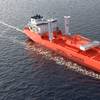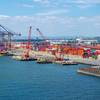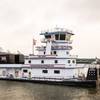The designer of Sleipner, the high-speed ferry that hit rocks and sank off Norway, said that the accident was a freak and insisted that the ultra-modern catamarans were safe.
Asbjoern Tolo said the ill-fated boat must have suffered unusually severe damage from the collision in rough seas that punctured both hulls. "This type of vessel is safe but freak things like this happen," Tolo said.
The two aluminum hulls of the Australian-built catamaran, which had a capacity of 358 passengers and a top speed of about 36 knots, each had seven airtight compartments.
Under international regulations, the ship should be able to sustain damage to two compartments in each hull without sinking. Tolo said Sleipner's design meant that it could probably tolerate up to three compartments at the bow being pierced without going down.
The damage from the collision, therefore, must have been extensive, he said. Similar high-speed craft have been in serious accidents, but none have sunk until now.
"This is the first time that such a vessel has hit rocks and damaged both hulls along the length (of the ship). It's the worst thing that could possibly happen," said Tolo, who works for Norwegian firm Paradis Nautica AS.
He said video pictures from a mini-submarine showed wreckage of the vessel's bow lying about 656 ft. (200 m) from the rest of the ship, which lies tilted toward the port side almost 329 ft. (100 m) down on the sea floor. The stern appeared relatively undamaged. "It must have hit the rock hard," Tolo said.
Classification society Den Norske Veritas, which sets shipping safety standards, has about 70 percent of the world's fleet of 1,000 high-speed light craft under classification. It says the track record of catamarans showed fewer accidents and deaths than traditional mono-hull vessels.
In 30 years of operation, there had been 17 accidents involving fatalities. Previously, the worst was in Hong Kong in the early 1990s when seven people died in a collision with another vessel, said DNV spokesman Tore Hoeifoedt. In that case, the catamaran remained floating.
"That shows how difficult it is for these vessels to sink. In a risk analysis, I wouldn't believe that this (chance of sinking) is a substantial risk element," he said. Hoeifoedt said DNV would await the outcome of an inquiry into the accident before deciding if it needed to make any changes to its procedures. The Sleipner was under DNV classification. - (Tanya Pang, Reuters)
Subscribe for
Maritime Reporter E-News
Maritime Reporter E-News is the maritime industry's largest circulation and most authoritative ENews Service, delivered to your Email five times per week









